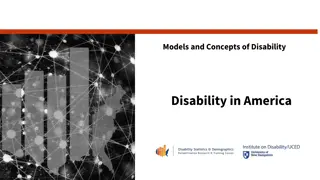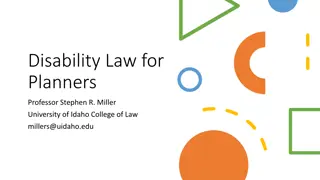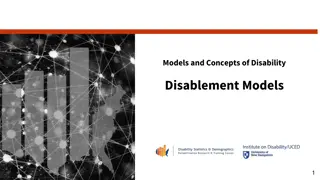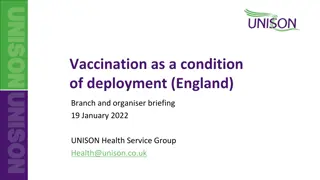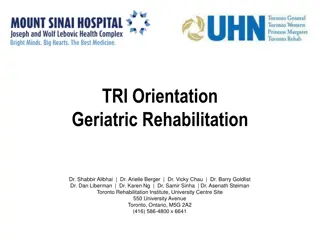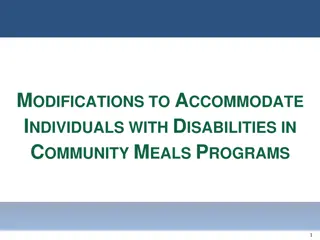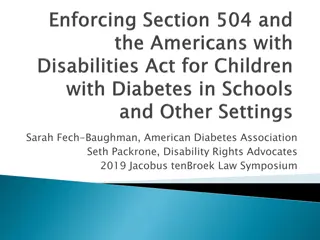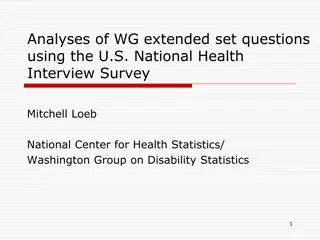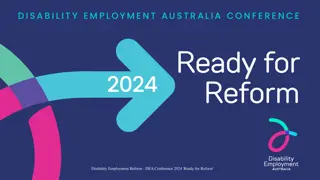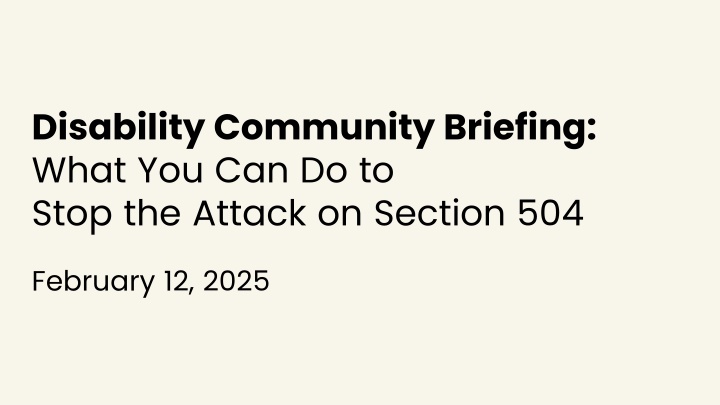
Section 504 of the Rehabilitation Act and Updated Regulations
Learn about Section 504 of the Rehabilitation Act, its significance, the implications of Texas v. Becerra case, and how the updated Department of Health and Human Services (HHS) regulations impact access to healthcare and human services. Discover what actions you can take to protect Section 504 rights. Join the Disability Community Briefing to empower yourself and support independent living for all.
Download Presentation

Please find below an Image/Link to download the presentation.
The content on the website is provided AS IS for your information and personal use only. It may not be sold, licensed, or shared on other websites without obtaining consent from the author. If you encounter any issues during the download, it is possible that the publisher has removed the file from their server.
You are allowed to download the files provided on this website for personal or commercial use, subject to the condition that they are used lawfully. All files are the property of their respective owners.
The content on the website is provided AS IS for your information and personal use only. It may not be sold, licensed, or shared on other websites without obtaining consent from the author.
E N D
Presentation Transcript
Disability Community Briefing: What You Can Do to Stop the Attack on Section 504 February 12, 2025
Welcome! Disability Community Briefing on Texas v. Becerra (N.D. Tex.) Case filed in federal court attacking Section 504 of the Rehabilitation Act Historical photo from the Section 504 Sit Ins 3
Presenters Claudia Center (she/her), Legal Director, Disability Rights Education & Defense Fund Theo Braddy (he/him), Executive Director, National Council on Independent Living Alison Barkoff (she/her), Director, Hirsh Health Law & Policy Program at GWU. Previous: Acting Administrator & Asst. Secretary for Aging, Principal Deputy Administrator, ACL, U.S. Dep t of Health & Human Services Howard Rosenblum (he/him), Chair, Deaf Equality Chloe Rothschild (she/her), Autistic Self-Advocate, Presenter, Author, Board Member of The Arc of the United States Steven Schwartz (he/him), Founder & Special Counsel, Center for Public Representation 4
Topics to Be Covered What is Section 504? What is the Spending Clause? What are Section 504 regulations? Updated (May 2024) HHS Section 504 regulations What is Texas v. Becerra? What risks does this case pose? How does Section 504 and the updated regulations support independent living? Video: Perspective of an autistic self-advocate Action Alert Questions & Answers 5
Section 504 of the Rehabilitation Act Short statute first enacted 1973 46 words! Applies to any entity that receives federal financial assistance this means federal dollars 504 = Spending Clause statute This is a clause in the U.S. Constitution (Article I, Section 8, Clause 1) Other Spending Clause statutes cover race and sex discrimination All the detail is in the Section 504 regulations First adopted in 1977 The Power of 504 Crip Camp 6
Department of Health and Human Services (HHS) Updated Section 504 Regulations Updated Section 504 regulations cover all HHS-funded programs and activities, including: Doctors, hospitals and medical facilities that take Medicaid or Medicare State Medicaid, disability and aging programs Child welfare systems Clinical research Longstanding discrimination in health and human services became even more visible during the COVID-19 pandemic Discrimination in accessing lifesaving treatment People losing services and forced into institutions with the highest death rates Inaccessible information, websites, and vaccination sites 7
The Disability Community Shaped the Section 504 Regs Disability community pushed to update the Section 504 regulations Disability advocates identified the major areas where updated regulations were needed Notice of Proposed Rulemaking (NPRM) issued in September 2023 Described evidence and reasons for updating rule and asked for feedback More than 5,000 comments from disabled people, advocacy organizations and other stakeholders Final Section 504 rule issued in May 2024 Responded to all public comments Described the changes made (and not made) in response to comments and why 8
Major Areas in the Updated Section 504 Regs No Discrimination in Medical Treatment Prohibits medical decisions based on bias/stereotypes, judgments that disabled people are a burden, or beliefs that the lives of disabled people are worth less Applies to organ transplantation, life-sustaining treatment, clinical research, and crisis standards of care Prohibits the use of value assessment methods that place a lower value on the lives of disabled people (like Quality Adjusted Life Years or QALYs) when used to limit of deny access to benefits or services 10
Major Areas in the Updated Section 504 Regs (2) Accessible Medical Equipment Requires covered providers to ensure accessible medical equipment Exam tables, mammogram machines and weight scales Set number of accessible equipment items within two years Aligned with DOJ Title II rules for public entities Accessible Websites and Mobile Apps Sets accessibility standards for websites and mobile apps (WCAG 2.1) Aligned with DOJ Americans with Disabilities Act (ADA) Title II standards for public entities Requires accessible kiosks 11
Major Areas in the Updated Section 504 Regs (3) Integration and Olmstead Puts into regulation extensive case law interpreting the integration mandate and the Olmstead decision Defines integration & segregation Explicit application to residential, day and educational services Coverage of people in or at risk of institutionalization & segregation 12
Major Areas in the Updated Section 504 Regs (4) Effective Communication Aligned with strong DOJ Title II standards for public entities Primary consideration to requests of disabled person Examples: sign language, captions, alternative formats, plain language Reasonable modifications Includes supported decision-making 13
Major Areas in the Updated Section 504 Regs (5) Child Welfare Systems Prohibits discrimination against parents/prospective parents with disabilities and disabled children with disabilities in or at risk of entering foster care Covers child welfare services like parent-child visitation, reunification services, child placement, parenting skills programs and in- and out-of- home services Service animals, accessibility standards, mobility devices, etc. aligned with ADA regulations 14
The Section 504 Regs Are Now In Effect Section 504 Regulations became effective July 8, 2024 (60 days after publication Can be enforced by HHS Office for Civil Rights or private lawyers (like protection and advocacy agencies) The law and regulations remain in place unless and until a court makes a decision otherwise or HHS changes them through notice and comment rulemaking More info on the regulations (working pages as of 2/10/25): HHS OCR webpage HHS Administration for Community Living webpage 15
The Legal Challenge to 504 Texas v. Becerra On September 26, 2024, Texas and 16 other states (in red) filed a lawsuit in the Northern District of Texas The case challenges the new 504 rule And even the constitutionality of Section 504 of the Rehabilitation Act The challenge to the rule attacks transgender people, disabled people, and people living at the intersection of both identities. Hence, a need for a united response. 16
The Legal Challenge to 504 Texas v. Becerra (2) The lawsuit also claims that requirements to provide services in the most integrated setting and to people at risk of institutionalization Are illegal and improper And are inconsistent with the Olmstead decision It claims that the entire rule is arbitrary and capricious (invalid), because it interferes with the State s discretion in providing disability services Mostly the states are concerned with the cost of compliance, particularly for Medicaid and Medicare health care services 17
The Legal Challenge to 504 Texas v. Becerra (3) Screenshot from the complaint 18
The Legal Challenge to 504 Texas v. Becerra (4) Fifty years after Section 504 of the Rehabilitation Act was passed, this new lawsuit claims that banning discrimination in all federally-funded programs is and always was unconstitutional because Congress cannot restrict the use of all federal funds in this way. What this could mean That other civil rights statutes which prohibit discrimination on the basis of race, sex, and ethnicity are also unconstitutional. And because the Americans with Disabilities Act (ADA) s enforcement scheme cross-references Section 504 and other discrimination statutes, it may imperil the ADA as well. 19
The Legal Challenge to 504 Texas v. Becerra (5) Screenshots from the complaint 20
The Status of the Case Initially, DOJ planned to aggressively defend both the rule and the statute, and agreed to a tight timeline for filing all briefs, which the Court adopted Recently, the parties asked to pause this timeline while the confer about the status of the rule and the case The Court ordered a status report by February 25, 2025 There now is great uncertainty about whether DOJ will defend the rule, the statute, or the case Similarly, there is uncertainty whether Texas and the other states will dismiss the case even if HHS withdraws or reconsiders the rule 21
Next Steps Given these uncertainties, which may not be fully resolved later this month, disability advocates are preparing for all options Some organizations may be willing to join the case or present arguments in favor of the rule and statute through amici briefs Some members of Congress and progressive attorneys general may be willing to help as well But this is a clear threat to the rights of disabled people everywhere, and even to the basic, long standing laws which we fought hard to pass 22
Testimony: Theo Braddy Executive Director, National Council on Independent Living 23
Testimony: Howard Rosenblum Chair, Deaf Equality 24
Testimony: Chloe Rothschild Autistic Self- Advocate, Presenter, Author, Board Member of The Arc of the United States Thumbnail of video, photo of Chlow speaking to the camera 25
How You Can Take Action
Tell Your State Attorney General to Stop Attacking Section 504 Visit dredf.org/protect-504 Contact Your State Attorney General By email (next slide has sample language) By contact form / website By phone 27
Example Email To: attorney.general@alaska.gov Subject: Stop Attacking Section 504! Drop Out of Texas v. Becerra! Dear Attorney General [Treg Taylor], [Say who you are] I live in Juneau, Alaska, and I have a disability. I am hard of hearing and use a wheelchair. I volunteer for the Southeast Alaska Independent Living Center. I go to college part time. [Say why you support Section 504 and its rules] I care about Section 504. I can go more places in my wheelchair because of Section 504. I can go to the doctor and use a scale for people who use wheelchairs. I can get captions for my college classes. I support the updated Section 504 rules. The updated rules are stronger and give more examples of what disability discrimination is. 29
Example Email (continued) [Say why Texas v. Becerra is bad] I am very upset and angry that you have joined a case in Texas called Texas v. Becerra that goes against Section 504 and the updated rules. You are asking the court to get rid of the Section 504 rules and the entire law. If the court does what you ask, I will not be able to go to the doctor or my college classes and get equal treatment. I will not have equal rights. This will be true for all the other disabled people in Alaska. [Say you want them to drop out of the case] I want you to drop out of Texas v. Becerra. You should support Section 504 and its rules. You should not be attacking our rights. [Ask for a meeting] I want you to meet with me and other people with disabilities. We want to talk to you about the case and why we are so concerned about it. Sincerely, [Your name] 30
We must continue to work in coalition with each other to protect Section 504, and other disability rights laws, no matter where the threat is coming from. 31


